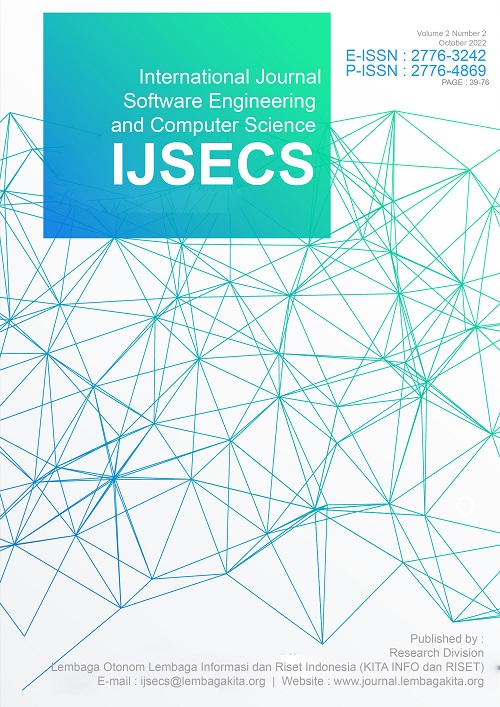Published: 2022-10-30
Billing Barber Shop (An Implementation of GoodBarber App Builder)
DOI: 10.35870/ijsecs.v2i2.798
Upik Sri Sulistyawati, Bahruni, Afrizal, Alfina
- Upik Sri Sulistyawati: Institut Teknologi dan Bisnis Muhammadiyah Bali
- Bahruni: STMIK Indonesia Banda Aceh
- Afrizal: E-Padi Coorporation and Lembaga KITA ,
- Alfina: STMIK Indonesia Banda Aceh
Abstract
The research objective is to develop a Billing Barbershop application by implementing GoodBarber App Builder in application development. The research method used in this study consists of 5 parts, namely the literature study method, data collection method, analysis method, design method, and the development method used is extreme programming. From the research results, a Billing Barber Shop application has been developed by implementing the GoodBarber App Builder which is designed to consist of login, home, billing, orders, product, and users forms. The test results are known in Usability testing, Compatibility testing, Interface testing, Low level resource, Performance testing, Operational testing, Installation testing, and Security testing stating very good with an average percentage above 80%. But in Service testing, choosing poor because Billing Barber Shop still uses the internet as a connection to data using Zapier Add-ons and Google Sheets.
Keywords
Billing ; Barber Shop ; GoodBarber App Builder ; Mobile
Article Metadata
Peer Review Process
This article has undergone a double-blind peer review process to ensure quality and impartiality.
Indexing Information
Discover where this journal is indexed at our indexing page to understand its reach and credibility.
Open Science Badges
This journal supports transparency in research and encourages authors to meet criteria for Open Science Badges by sharing data, materials, or preregistered studies.
How to Cite
Article Metrics
- Views0
- Downloads0
- Scopus Citations
- Google Scholar
- Crossref Citations
- Semantic Scholar
- DataCite Metrics
If the link doesn't work, copy the DOI or article title for manual search (API Maintenance).
Article Information
This article has been peer-reviewed and published in the International Journal Software Engineering and Computer Science (IJSECS). The content is available under the terms of the Creative Commons Attribution 4.0 International License.
-
Issue: Vol. 2 No. 2 (2022)
-
Section: Articles
-
Published: October 30, 2022
-
License: CC BY 4.0
-
Copyright: © 2022 Authors
-
DOI: 10.35870/ijsecs.v2i2.798
AI Research Hub
This article is indexed and available through various AI-powered research tools and citation platforms. Our AI Research Hub ensures that scholarly work is discoverable, accessible, and easily integrated into the global research ecosystem. By leveraging artificial intelligence for indexing, recommendation, and citation analysis, we enhance the visibility and impact of published research.




Upik Sri Sulistyawati
Assistant Professor, Prodi Kewirausahaan, Institut Teknologi dan Bisnis Muhammadiyah Bali
-
-
-
Lawson, H.M., 1999. Working on hair. Qualitative Sociology, 22(3), pp.235-257. DOI: https://doi.org/10.1023/A:1022957805531.
-
-
-
-
-
-
-
-
Goodbarber. 2022. Let's make beautiful apps. URL: https://www.goodbarber.com/. Accessed October 11, 2022.
-
Wahyuddin, M.I., Aldisa, R.T., Fauziah, F. and Sholihati, I.D., 2021. Sistem Informasi Administrasi Kemahasiswaan dan Alumni (Smart Adma) dengan Metode Extreme Programming (XP). Jurnal JTIK (Jurnal Teknologi Informasi dan Komunikasi), 5(4), pp.425-429. DOI: https://doi.org/10.35870/jtik.v5i4.256.
-
-
-
-
Rahmansyah, N., Muliyani, D., Mardiani, E. and Rahman, A., 2022. Perancangan Sistem Transaksi Berbasis Web pada UKM Pangkas Rambut Tasik. Jurnal Sistem Informasi Bisnis (JUNSIBI), 3(1), pp.22-31. DOI: https://doi.org/10.55122/junsibi.v3i1.412.
-
Kesumaningtyas, F. and Alriski, A., 2022. Reservasi Pangkas Rambut Pada Barbershop Razor Bukittinggi. Jurnal Sains dan Teknologi: Jurnal Keilmuan dan Aplikasi Teknologi Industri, 22(1), pp.127-129. DOI: http://dx.doi.org/10.36275/stsp.v22i1.476.
-
Tussa'ddia, N., Harlinda, H. and Mude, M.A., 2021. Aplikasi Pencarian Barbershop Menggunakan Metode Harversine Formula Untuk Menentukan Jarak Terdekat. Buletin Sistem Informasi dan Teknologi Islam, 2(1), pp.56-63.DOI: https://doi.org/10.33096/busiti.v2i1.759.
-
Salam, A., and Fathurrahmad. 2022. Sistem Pengambilan Keputusan Penentuan Lokasi Beauty Shop Menggunakan Metode Simple Additive Weighting (SAW). Journal Innovations Computer Science, 1(1), 1–13. https://doi.org/10.56347/jics.v1i1.24.

This work is licensed under a Creative Commons Attribution-NonCommercial-NoDerivatives 4.0 International License.
Copyright and Licensing Agreement
Authors who publish with this journal agree to the following terms:
1. Copyright Retention and Open Access License
- Authors retain full copyright of their work
- Authors grant the journal right of first publication under the Creative Commons Attribution 4.0 International License (CC BY 4.0)
- This license allows unrestricted use, distribution, and reproduction in any medium, provided the original work is properly cited
2. Rights Granted Under CC BY 4.0
Under this license, readers are free to:
- Share — copy and redistribute the material in any medium or format
- Adapt — remix, transform, and build upon the material for any purpose, including commercial use
- No additional restrictions — the licensor cannot revoke these freedoms as long as license terms are followed
3. Attribution Requirements
All uses must include:
- Proper citation of the original work
- Link to the Creative Commons license
- Indication if changes were made to the original work
- No suggestion that the licensor endorses the user or their use
4. Additional Distribution Rights
Authors may:
- Deposit the published version in institutional repositories
- Share through academic social networks
- Include in books, monographs, or other publications
- Post on personal or institutional websites
Requirement: All additional distributions must maintain the CC BY 4.0 license and proper attribution.
5. Self-Archiving and Pre-Print Sharing
Authors are encouraged to:
- Share pre-prints and post-prints online
- Deposit in subject-specific repositories (e.g., arXiv, bioRxiv)
- Engage in scholarly communication throughout the publication process
6. Open Access Commitment
This journal provides immediate open access to all content, supporting the global exchange of knowledge without financial, legal, or technical barriers.
